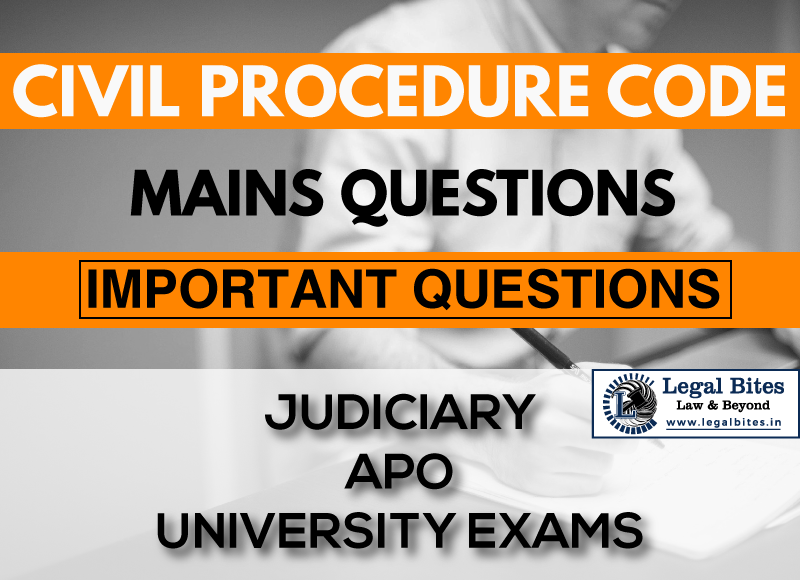Meaning and Procedure of Review under the Code of Civil Procedure, 1908
Review of a judgment passed by a lower civil court is a substantive right under Section 114 of the Civil Procedure Code and Order XLVII prescribes the conditions and procedure to review a judgment. This article aims to explain this meaning and procedure of review under CPC. Introduction The Latin doctrine ‘functus officio’ is applicable with respect to… Read More »
;
Review of a judgment passed by a lower civil court is a substantive right under Section 114 of the Civil Procedure Code and Order XLVII prescribes the conditions and procedure to review a judgment. This article aims to explain this meaning and procedure of review under CPC. Introduction The Latin doctrine ‘functus officio’ is applicable with respect to a judgment passed by any court following due procedure of law. The doctrine means that a case cannot be re-opened if a judgment in the...
Review of a judgment passed by a lower civil court is a substantive right under Section 114 of the Civil Procedure Code and Order XLVII prescribes the conditions and procedure to review a judgment. This article aims to explain this meaning and procedure of review under CPC.
Introduction
The Latin doctrine ‘functus officio’ is applicable with respect to a judgment passed by any court following due procedure of law. The doctrine means that a case cannot be re-opened if a judgment in the case has been pronounced after a due and fair hearing and trial. The right to file for a review of a judgment is an exception to the Latin concept of functus officio.
The term ‘review’ means ‘to re-examine or to study again’. In a legal sense it means filing an application before the court which passed the decree requesting it to re-examine the material facts and evidence in the case and pronounce a decree again.
Review under Section 114
Section 114 of the code enables a person to file an application or review petition before the court to re-examine the case decided by that court itself. The essential features of the provision are:
- Aggrieved Person: The power to file for review is available with a person who is aggrieved from any decree or order pronounced by a court. An aggrieved person, basically, means the judgment-debtor, i.e. the person against whom the decree has been passed. A person who is the decree-holder cannot file an application for the review of a case.
- Appeal not Filed: Review is allowed in a case where the CPC allows an appeal to be filed but, however, the aggrieved party has decided not to file an appeal and rather a review petition. It basically means it can be filed only before appeal and not after an appeal is moved.
- Appeal not Allowed: Under Section 114, a review can be filed for a decree or order from which appeal is disallowed under the CPC. For instance, an appeal is not allowed from any compromise decree, i.e. a decree passed on the basis of mutual settlement between the parties. Hence, a review petition can be filed for the same.
- By reference: When a case is referred from a court of small causes to a higher court (civil court junior or senior division) for determination and the case is decided by the said civic court, a review petition can be filed by the person aggrieved by the decision of the court. The power to review a judgement is vested upon the court which has passed the decree. Such power is discretionary in nature and depending on the merits of the case, the court can allow or dismiss the review petition.
Application for review
Under rule 1 of Order XLVII of the civil procedure code any person who is aggrieved by a decree or an order of a court and if one of the four aforesaid circumstances exists, then the person can file an application for the review of the decree or order.
The available grounds for filing are as follows:
- The aggrieved party must have found certain new material facts or evidence which the party was unable to procure and produce before the court at the time when the court passed the decree despite exercising due care and diligence. However, under Rule 4, a mere statement of the applicant cannot be sufficient to accept that a new piece of evidence has suddenly come to the party’s possession and was genuinely not in his knowledge before. Hence, any such claim must be proved before the court with no room for doubts or suspicion.
- There was a mistake or an error committed by the Hon’ble court which was apparent on the face of record while pronouncing the decree, because of which the party believes that the decree has been influenced and could be passed in his favour either. In the case of Usha Rani v. Hardas Das[1], the Guwahati High Court observed that what is an error apparent on the face of record depends on the fact and circumstances of each case.
- Rule 1 uses the expression “any other sufficient reason”. In Lily Thomas v. Union of India[2], it was clarified by the court that any reason can be any reason which the court believes to be sufficient to allow a review of the judgment provided that the reason is at least analogous to the provisions of Rule 1 Order XLVII.
- A misconception or misinterpretation of the factual scenario of the case can be a valid ground for a party to file an application of review of the judgment[3].
If the court considers that the application filed for review has substantial grounds for review, the application may be granted. Nevertheless, the court must serve a notice of the review petition to the opposite party to allow him/her to appear before the court and defend his case.
Process of Review
According to Rule 5 of Order XLVII, if any decree or order is sought to be reviewed by a party to the suit, it can only be reviewed by the judge or bench (in case the original decree was passed by two or more judges) which passed the original decree or order. The rationale for this provision is that the term review indicates to look again.
The purpose is to look for any mistake or deficiency that occurred last time the case was decided. Hence, the bench that decided that the case would be in the best possible situation to review the same. Further, the judges would know the reason for passing the decree or order while any other judge may not be able to appreciate the matter as well as the original bench. Therefore, a judgment can be reviewed only by the judge(s) who decided the case.
However, Rule 5 makes an exception to deal with situations where the judges or one of the judges who pronounced the judgment is absent and cannot hear the case for anytime sooner than six months from the date of filing of the application of review. The provision allows any other competent judge or any other court of competent jurisdiction to hear the review petition and pass any order as it may deem fit.
Rejection of Review Petition
According to Rule 6, a review petition can be rejected in two ways. Firstly, when the application was heard by two or more judges and the judges are equally divided in their opinion as to whether the review should be allowed or not.
Secondly, when the judges by majority decide that there is no sufficient reason for allowing the review, the court by the majority can reject the petition. Hence, the court should, by a majority, accept the review application to allow a review and even a tie between the judges cannot grant a review to the aggrieved party.
There can be several grounds for rejection. These grounds are:
- When the applicant or petitioner fails to satisfy the court that there is new evidence that needs to be considered or that the court has committed an error apparent on the face of record, the court may reject the petition.
- According to the Supreme Court Rules, a review application before the Supreme Court must be made before the expiry of 30 days from the date of pronouncement of the decree or order. Similarly, every review application has a time limit within which it must be filed. If an application is barred by limitation, the court may reject it.
- Suppose A sued B for acquiring permanent injunction but the decree was not passed in his favour and he applied for a review of the decree before the same court. In the review, the decree was reversed and the court found that there was an error and A was declared the decree-holder. Now, B cannot file a review application for the review of the reversed decree. Hence, review of a reviewed order or decree is not allowed and an application for the same shall be rejected by the court.
- After a review application is filed, the court fixes a date for the first hearing of the review application and the applicant is called for the hearing. If the applicant fails to appear either himself or through a pleader without justification, the court may reject the application. A party aggrieved by an order of rejection of review petition can file an application for restoring it to file if s/he can satisfy the court that there was sufficient cause beyond his control compelling his non-appearance on the fixed date.
According to Rule 7, an order of rejection of review application is not appealable and shall be binding between the parties. Although an order granting the review application can be objected and appealed before an appellate court, the order of rejection remains as it is. After the review application is accepted and the court has reviewed the decree or order, the court shall pronounce the reviewed judgment and it shall be binding on the parties.
In M.B. Catholicos v. M. Poulose[4], the apex court observed that after the acceptance of the review petition, the court proceeds with the process of rehearing the case. The decision of the court after rehearing the matter shall be binding on the parties concerned.
References:
- Dinshaw F. Mulla, the Key to Indian Practice: A Summary of the Code of Civl Procedure, 1908, (11th 2015).
- K. Takwani, Civil Procedure, (8th ed. 2018).
[1] Usha Rani v. Hardas Das, AIR 2005 Gau 01.
[2] Lily Thomas v. Union of India, AIR 2000 SC 1650.
[3] Soumitra Panda v. A.K Agarwal, AIR 1994 Cal 165.
[4] M.B. Catholicos v. M. Poulose, AIR 1954 SC 526.



